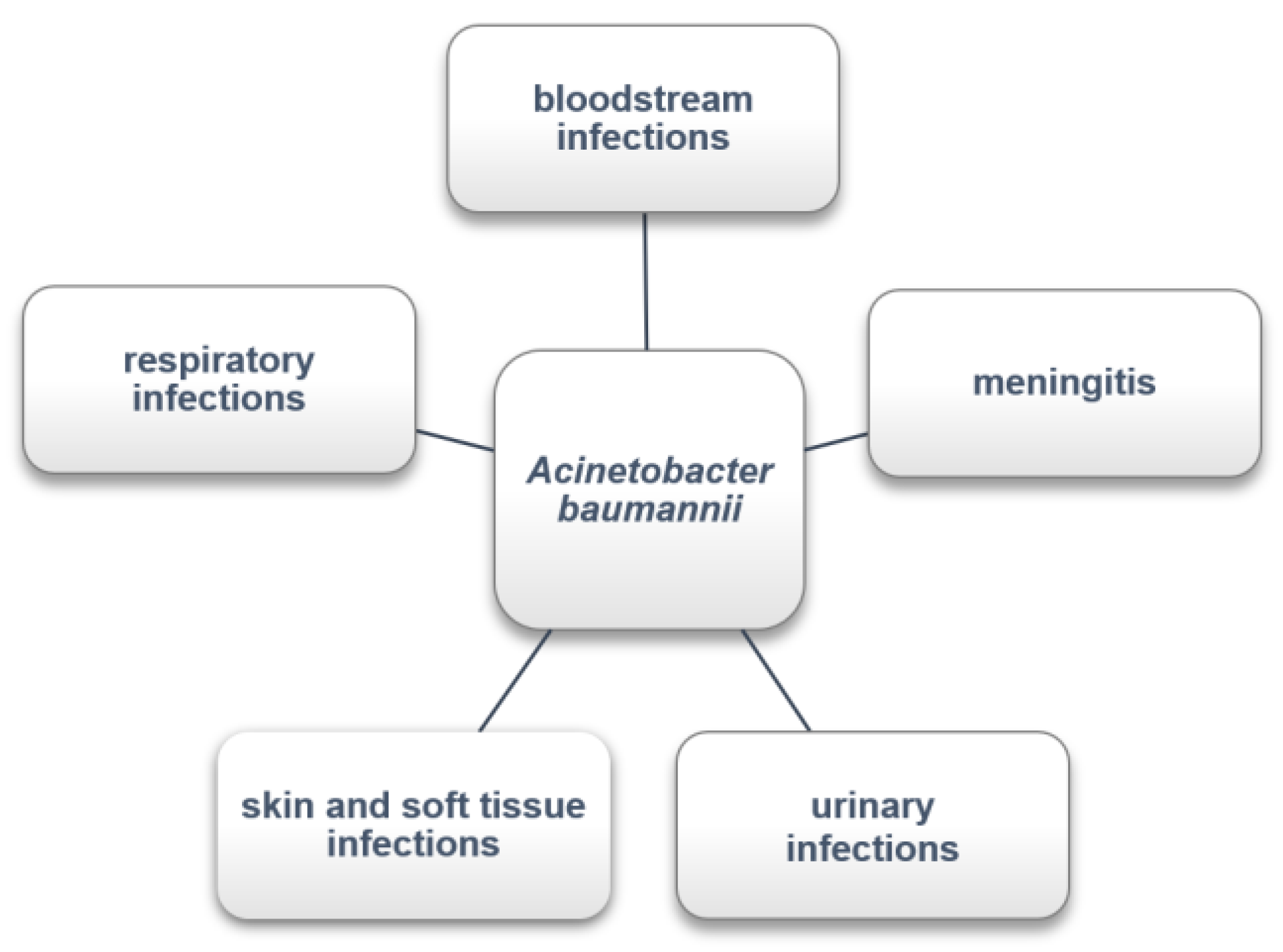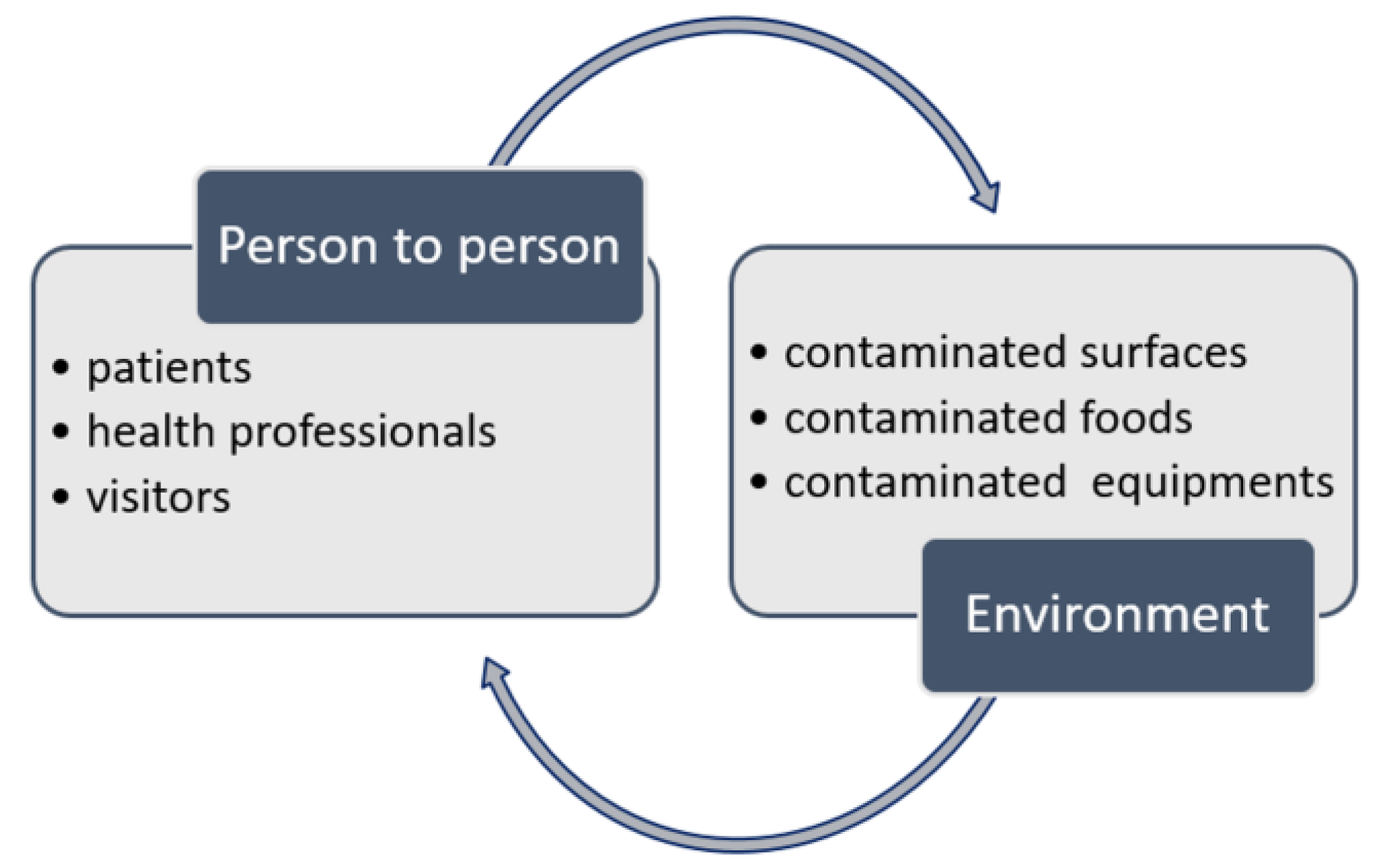Acinetobacter baumannii: A Known Pathogen, a New Problem
Author Contributions
Funding
Conflicts of Interest
References
- Wong, D.; Nielsen, T.B.; Bonomo, R.A.; Pantapalangkoor, P.; Luna, B.; Spellberg, B. Clinical and pathophysiological overview of Acinetobacter infections: a century of challenges. Clin Microbiol Rev. 2017, 30, 409–447. [Google Scholar] [CrossRef]
- World Health Organization (WHO). Global priority list of antibiotic-resistant bacteria to guide research, discovery, and development of new antibiotics. 2017. Available online: https://www.who.int/news/item/27-02-2017-who-publishes-list-of-bacteria-for-which-new-antibiotics-areurgently-needed (accessed on 31 August 2023).
- Bartal, C.; Rolston, K.V.I.; Nesher, L. Carbapenem-resistant Acinetobacter baumannii: colonization, infection and current treatment options. Infect Dis Ther. 2022, 11, 683–694. [Google Scholar] [CrossRef] [PubMed]
- Centers for Disease Control and Prevention (CDC). Antimicrobial resistance. 2019 AR Threats Report. 2019. Available online: https://www.cdc.gov/drugresistance/biggestthreats.html (accessed on 31 August 2023).
- O’Donnell, J.N.; Putra, V.; Lodise, T.P. Treatment of patients with serious infections due to carbapenem-resistant Acinetobacter baumannii: how viable are the current options? Pharmacotherapy 2021, 41, 76280. [Google Scholar] [CrossRef] [PubMed]
- Russo, A.; Gavaruzzi, F.; Ceccarelli, G.; et al. Multidrugresistant Acinetobacter baumannii infections in COVID19 patients hospitalized in intensive care unit. Infection 2022, 50, 83–92. [Google Scholar] [CrossRef]
- Iacovelli, A.; Oliva, A.; Siccardi, G.; et al. Risk factors and effect on mortality of superinfections in a newly established COVID-19 respiratory sub-intensive care unit at University Hospital in Rome. BMC Pulm Med. 2023, 23, 30. [Google Scholar] [CrossRef] [PubMed]
- Pettit, N.N.; Nguyen, C.T.; Mutlu, G.M.; et al. Late onset infectious complications and safety of tocilizumab in the management of COVID-19. J Med Virol. 2021, 93, 145964. [Google Scholar] [CrossRef]
- Shinohara, D.R.; Dos Santos Saalfeld, S.M.; Martinez, H.V.; et al. Outbreak of endemic carbapenem-resistant Acinetobacter baumannii in a coronavirus disease 2019 (COVID-19)-specific intensive care unit. Infect Control. Hosp Epidemiol. 2022, 43, 815–817. [Google Scholar] [CrossRef] [PubMed]
- Silva, D.L.; Lima, C.M.; Magalhães, V.C.R.; et al. Fungal and bacterial coinfections increase mortality of severely ill COVID-19 patients. J Hosp Infect. 2021, 113, 145–154. [Google Scholar] [CrossRef]
- Jin, X.; Zeng, L.; Zhang, L.; Zhu, Z. Co-infection in COVID19 patients performed microbiology detection: discovering multidrug resistant microorganisms increased during the COVID-19 pandemic in Shanghai, China. J Glob Antimicrob Resist. 2023, 35, 48–50. [Google Scholar] [CrossRef] [PubMed]
- Kim, J.Y.; Lee, W.J.; Suh, J.W.; Kim, S.B.; Sohn, J.W.; Yoon, Y.K. Clinical impact of COVID-19 in patients with carbapenem-resistant Acinetobacter baumannii bacteraemia. Epidemiol Infect. 2023, 151, e180. [Google Scholar] [CrossRef] [PubMed]
- Centers for Disease Control and Prevention (CDC). COVID-19: U.S. Impact on Antimicrobial Resistance, Special Report 2022; U.S. Department of Health and Human Services, CDC: Atlanta, GA, USA, 2022. [Google Scholar] [CrossRef]
- de Carvalho Hessel Dias, V.M.; Tuon, F.; de Jesus Capelo, P.; Telles, J.P.; Fortaleza, C.M.C.B.; Pellegrino Baena, C. Trend analysis of carbapenem-resistant Gram-negative bacteria and antimicrobial consumption in the postCOVID-19 era: an extra challenge for healthcare institutions. J Hosp Infect. 2022, 120, 43–47. [Google Scholar] [CrossRef]
- Meade, E.; Slattery, M.A.; Garvey, M. Biocidal resistance in clinically relevant microbial species: a major public health risk. Pathogens. 2021, 10, 598. [Google Scholar] [CrossRef]


© GERMS 2023.
Share and Cite
Monteiro, R.C.; Malta, R.C.R.; Rodrigues, G.L.; Ramos, G.L.d.P.A.; Nascimento, J.d.S. Acinetobacter baumannii: A Known Pathogen, a New Problem. GERMS 2023, 13, 381-384. https://doi.org/10.18683/germs.2023.1408
Monteiro RC, Malta RCR, Rodrigues GL, Ramos GLdPA, Nascimento JdS. Acinetobacter baumannii: A Known Pathogen, a New Problem. GERMS. 2023; 13(4):381-384. https://doi.org/10.18683/germs.2023.1408
Chicago/Turabian StyleMonteiro, Ricardo Campos, Rogerio Caldeira Rodrigues Malta, Geovana Lacerda Rodrigues, Gustavo Luis de Paiva Anciens Ramos, and Janaína dos Santos Nascimento. 2023. "Acinetobacter baumannii: A Known Pathogen, a New Problem" GERMS 13, no. 4: 381-384. https://doi.org/10.18683/germs.2023.1408
APA StyleMonteiro, R. C., Malta, R. C. R., Rodrigues, G. L., Ramos, G. L. d. P. A., & Nascimento, J. d. S. (2023). Acinetobacter baumannii: A Known Pathogen, a New Problem. GERMS, 13(4), 381-384. https://doi.org/10.18683/germs.2023.1408



